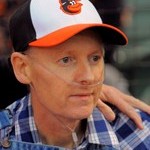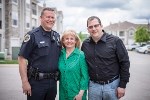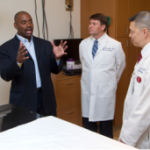Orioles ‘Zill Billy’ usher is Swinging at Lung Cancer
August 17th, 2013 BALTIMORE (WMAR) – The familiar sounds of John Denver’s “Thank God I’m a Country Boy” during the 7 th inning stretch at Camden Yards brought Charlie Zill front and center to entertain fans as his character, Zill Billy.
BALTIMORE (WMAR) – The familiar sounds of John Denver’s “Thank God I’m a Country Boy” during the 7 th inning stretch at Camden Yards brought Charlie Zill front and center to entertain fans as his character, Zill Billy.
“I was playing around one game and put in the teeth,” he said. “I had on a pair of suspenders and turned my hat sideways. I started dancing around, and people seemed to like it.”
An usher at Camden Yards for 17 seasons, Zill followed his passion for the Orioles that dated back to days spent at games with his uncle.
“He was like a mentor to me,” Zill said. “Ever since then, I wanted to work for the Orioles.”
Zill got that chance in 1996, quickly becoming a favorite around the yard. “It’s a privilege to work for the orioles,” he said.
Then, in 1998, after a little coaxing from fans, the Zill Billy was born.
“I’d never have done this if it wasn’t for them,” Zill said. “They created me and got me to do this.”
Zill kept the tradition going season after season, adding new steps and costume pieces along the way. “Each season, I tried to add something to make it better.”
Then in 2009, his life took a dramatic and irreversible turn.
“I had a chronic cough and went to the doctor. That’s when they told me I had lung cancer,” he said.
It was stage four cancer that came with a grim prognosis. “They gave me a year to live when I was diagnosed,” he said.
That was four years ago. In that time, Zill decided to keep dancing and thrilling the crowd as long as his body would let him.
“I believe my working for the o’s was medicine for me,” he said, fighting back tears. “Getting out there, doing my thing… I believe it helped. It helped me a lot.”
Eventually, the effects of the cancer proved too much, and last season during game two of the ALDS at Camden Yards, the Zill Billy knew it was time to give fans his last dance.
“I remember being so weak,” he said. “I didn’t think I was going to be able to do it, but God gave me the will power to go on.”
Today, in Red Lion, Penn., 60 miles from Baltimore, the rhythm of chimes, dancing on a windy morning, replaces the hum of the ballpark. Charlie Zill sits on a couch inside his red brick home tethered to an oxygen tank, fighting for every breath he has left.
“It’s hard for me to walk from here to the bathroom, and I’m out of breath, even with oxygen on,” he said.
He’s physically unable to return to Camden Yards now, but he’s not yet ready to throw in the towel. “I try to keep hope,” he said. “That’s the best thing to keep.”
He’s hoping for the outside chance of a cure and maybe one more trip to the ball park. He won’t be going there to work. This time, he gets to be the fan.
“I’m going to try. I don’t know,” he said. “Only the Lord knows, and I’ll let the spirits move me.”
If you’d like to send cards or letters Charlie Zill, you can send them to:
P.O. Box 604
Red Lion, PA 17356
Read more: http://www.abc2news.com/dpp/sports/baseball/orioles/orioles-zill-billy-usher-has-last-dance-battles-stage-four-cancer#ixzz2cGj9cBNy






